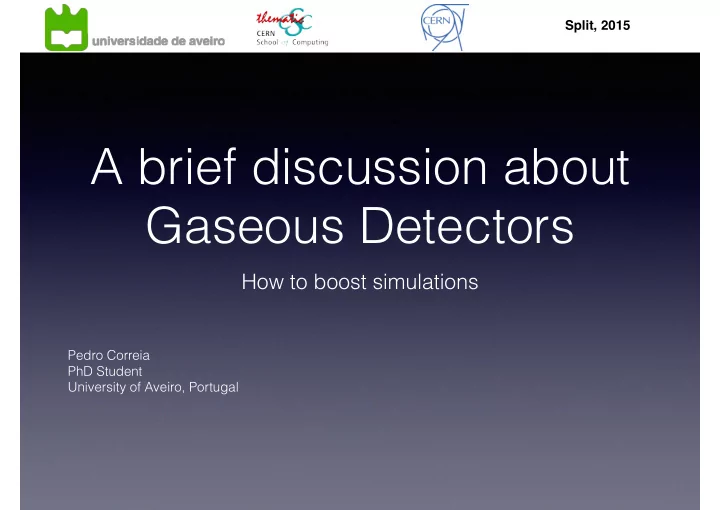

Split, 2015 A brief discussion about Gaseous Detectors How to boost simulations Pedro Correia PhD Student University of Aveiro, Portugal
� � ����� �� �� � ���� ��� ���������������� ����������� �� � ��� ���������� ���������� �� About Gaseous Detectors Radiation/particle detectors. Applications for HEP, • Medical Physics, Homeland, etc… Depending on applied voltage[1] • Measure deposited energy and/or count number of particles MicroPatterned Gaseous Detectors (MPGD) - • CERN RD51 Collaboration. App: Compass-RICH (as photodetectors), ATLAS and CMS (muons) • MPGD examples: GEM[2]: 2
How does a GEM work? GEM - Gas Electron Multiplier • Its all about electric charge creation/movement • and interaction with the medium (gas and detector) • Excitations • Ionizations (avalanches) • Others (attachments) Important parameter: Signal obtained (aka Gain). • Avalanche simulation of an incoming charged • particle 3
How does a GEM work? GEM - Gas Electron Multiplier • Its all about electric charge creation/movement • and interaction with the medium (gas and detector) • Excitations • Ionizations (avalanches) • Others (attachments) Important parameter: Signal obtained (aka Gain). • Avalanche simulation of an incoming charged • particle 3
Simulation toolkit: GARFIELD Created at CERN in 1984 (Fortran version), now Garf++ • “Toolkit for the detailed simulation of particle detectors • that use gas and semi-conductors as sensitive medium.” - Garfield website http://garfieldpp.web.cern.ch/garfieldpp/ • Tracking particles with Monte-Carlo techniques. • Code example Create charged Track every particles in gas collision (Monte-Carlo magic) Simulate Calculate interactions properties (gain, (ex:ionizat.) drift velocity, etc) 4
Boosting simulations Repeat for a range of Create Electric field Map Electric Potentials (ex: (ex: Ansys) 200-600V) Days/weeks/months of simulations ! Upload to Garfield Simulate up to 10 2 …10 6 independent primary electrons Gains up to 10 5 secondary particles 5
Boosting simulations Repeat for a range of Create Electric field Map Electric Potentials (ex: (ex: Ansys) 200-600V) Days/weeks/months of simulations ! Upload to Garfield Simulate up to 10 2 …10 6 independent primary electrons Gains up to 10 5 secondary particles 5
Boosting simulations Repeat for a range of Create Electric field Map Electric Potentials (ex: (ex: Ansys) 200-600V) Days/weeks/months of simulations ! Upload to Garfield Simulate up to 10 2 …10 6 independent primary electrons Gains up to 10 5 secondary particles 5
Boosting simulations Repeat for a range of Create Electric field Map Electric Potentials (ex: (ex: Ansys) 200-600V) Days/weeks/months of simulations ! Upload to Garfield Parallelization of this Simulate up to 10 2 …10 6 simulations is now being independent primary developed (tools OpenMP, electrons CUDA, …) Gains up to 10 5 secondary particles 5
Boosting simulations What if the physical behavior changes with Create Electric field Map time? Ex: Avalanches are dependent of the (ex: Ansys) previous… Upload to Garfield Simulate up to 10 2 …10 6 dependent primary electrons Gains up to 10 5 secondary particles 6
Boosting simulations What if the physical behavior changes with Create Electric field Map time? Ex: Avalanches are dependent of the (ex: Ansys) previous… Upload to Garfield Iterative method to simulate time evolution (few seconds - minutes) Simulate up to 10 2 …10 6 dependent primary electrons Gains up to 10 5 secondary particles 6
Final Message • Sometimes hard work in parallelization is not enough. Better and reliable algorithms are crucial, specially if you are developing your own applications. 7
References 1. G. F. Knoll, Radiation Detection and Measurements , third edition. John Wiley & Sons, Inc., 3rd ed., 1999. 2. CERN Courier, Dec 7, 2009: The continuing rise of micropattern detectors , http://cerncourier.com/ cws/article/cern/41011 8
Backups Illustration of charing-up on a GEM Charging-up effect: Dynamic accumulation of • charges in the insulator changes the local electric field, thus the response of the detector over the time Electric field intensity evolution over the time Azmoun, B.et al"A Study of Gain Stability and Charging Effects in GEM Foils," Nuclear Science Symposium Conference Record, 2006. IEEE , vol.6, no., pp. 3847,3851, Oct. 29 2006-Nov. 1 2006 doi: 10.1109/NSSMIC.2006.353830 9
Backups Illustration of charing-up on a GEM Charging-up effect: Dynamic accumulation of • charges in the insulator changes the local electric field, thus the response of the detector over the time Electric field intensity evolution over the time Azmoun, B.et al"A Study of Gain Stability and Charging Effects in GEM Foils," Nuclear Science Symposium Conference Record, 2006. IEEE , vol.6, no., pp. 3847,3851, Oct. 29 2006-Nov. 1 2006 doi: 10.1109/NSSMIC.2006.353830 9
Backups Illustration of charing-up on a GEM Charging-up effect: Dynamic accumulation of • charges in the insulator changes the local electric field, thus the response of the detector over the time Electric field intensity evolution over the time Azmoun, B.et al"A Study of Gain Stability and Charging Effects in GEM Foils," Nuclear Science Symposium Conference Record, 2006. IEEE , vol.6, no., pp. 3847,3851, Oct. 29 2006-Nov. 1 2006 doi: 10.1109/NSSMIC.2006.353830 9
Recommend
More recommend